
I’m an “old soul” who’s addicted to music. I had a record player growing up. It was a cheap plastic one, but I have fond memories of listening to my mom’s record collection on it. My mom and I have different tastes in music, but she had a few albums I loved. My favorite was, Pet Sounds.
The last several years, I’ve been browsing record players, and dreaming of piecing together a system. One of the reasons I still don’t have a record player is that I’m very particular about having it sound great, which will require a lot of money to achieve, and so…I save.
In talking to a long-time friend of mine, I shared my desire to own a turntable. As a fellow audiophile, I figured she might have a legitimate recommendation. When I asked her, she immediately said, “Have you looked at Gramovox?”
Gramovox is a record player manufacturer that “re-imagines vintage design with modern technology.” I’m almost sold on the tagline alone because it gets to the very intersection of what I want in a turntable. In vetting their product to determine whether or not make a purchase, I found myself evaluating them based on my perspective as an SEO. I found things they’re doing well as well as areas of opportunity and thought I’d share my feedback in the form of a site audit.
In this audit, I’m going to cover specific areas that are integral to improving SEO performance. They include on-page optimization, site architecture, broken links, redirects and navigation.
Let’s take a look at what Gramovox is doing well, where they have opportunities to improve and how you can relate it to your business.
*Note: In conducting this audit, I had limitations because I don’t have access to Gramovox’s site in Google Analytics, Search Console or similar tools useful for gathering deeper insights.
On-Page Optimization
Keyword Focus
In-depth keyword research is a foundational part of search engine optimization. I usually recommend beginning your SEO efforts here because it will determine your core terms in addition to more granular, next-level, long-tail keyword phrases worth targeting. This in turn will help focus your efforts and guide the optimization process. If you’ve started optimizing pages on your site and haven’t conducted keyword research, I’d suggest doing research before continuing to optimize pages. Once you have a list of your keywords, you can use them to implement on-page elements such as:
- Title tags
- Meta descriptions
- Heading tags
- Page content
- Image alt tags
I looked at each of these elements in my Gramovox audit and have compiled my feedback below. By further optimizing each element, Gramovox would likely notice a significant boost in overall search performance. Keyword research will provide keyword ideas and phrases to target, as well as what terms are bringing traffic to specific products and services by looking at their site in Google Search Console. The keywords that are relevant to your website content should be used in on-page elements to target users who are searching for your product or service. If you don’t already have content on your site that encompasses a group of keywords, but the keywords are applicable, develop new content.
I’ll address each element individually.
Title Tags
All of the Gramovox title tags are branded, which may be set-up by default. Branded title tags can be helpful to reinforce brand recognition, but since Gramovox isn’t a highly recognized brand, it may not be the best use of title tag character limitations. For instance, I searched for “record player” in Google and this is how their page appeared in organic search:

If my friend hadn’t told me about the brand, I wouldn’t have intuitively known what “Gramovox” is. I also would have been slow to click on this result because it doesn’t say in the title that it’s a record player. I’d have to scan down to the description to verify that it’s a player and not just a record.
I like that Gramovox has kept things simple, not only in their product line, but in the design of their site. However, the above title tag is simple to a fault. A better title tag would be: Floating Record Player: Vintage Design, Modern Technology – or if they didn’t want to remove the brand name from the title, Vintage Record Player Meets Modern Technology – Gramovox. These title tags do a better job of clearly representing what the searcher will get if they click on the link, while working in keywords naturally and still staying within the recommended 50-60 character title tag length.
I found only two pages with title tags that exceed 60 characters: here and here. That’s an easy fix, especially if they drop the brand from the tag. Both of these pages are on the blog, and it seems they are using the blog post title as the title tag for the page. Some platforms don’t allow you to customize these separately, but they are using Shopify, which does, so they should be able to customize the title tag without changing the title of the blog post.
Gramovox has one page that is accessible by two different URLs, which is why the pages are showing duplicate title tags. It is a blog post that can be found here and here. This is another easy fix. They just need to set up a 301 redirect from http://www.gramovox.com/blogs/posts/19159491-gramovox-now-at-at-ts-flagship-store to http://www.gramovox.com/blogs/posts/19159491-gramovox-now-in-the-at-t-flagship-store. It looks like the first URL was published incorrectly (now-at-at-ts) instead of (now-in-the-at-t), then the correct URL was created and published without 301 redirecting the incorrect URL, causing a duplicate page to be created.
If they optimize their title tags to include keywords, they should see a nice boost in search rankings and click-through rates, all while maintaining their simplicity.
Meta Descriptions
Search engines don’t always use the title tag or meta description that are in the source code of a page when the page is displayed in search results. This has evolved as search engines have incorporated semantic search into their results in attempt to deliver more relevant results. It’s still best practice to optimize these tags, but keep in mind they won’t always be what is presented to a searcher in the search results.
For example, I searched for “turntable” in Google, and here is the result they displayed for Gramovox:

Notice, this is the same URL that showed in the results for “record player,” but the results are different based on the search query. The meta description that Gramovox set for the page is, “Vertical Turntable with Full-Range Stereo Sound.”
Like with title tags, meta descriptions have an optimal character length. Meta descriptions should be between 150 and 160 characters. One reason Google may have opted for their own description, is that Gramovox’s description, at 47 characters, falls well short of 150 characters. This may lead Google to assume that the set description doesn’t provide searchers with enough information about what they will find if they click through to the page.
A good formula to use in writing meta descriptions is: verb + keywords + call-to-action. So, a good description for this page might be something like: “Get our vertical, high-performance turntable with full-range stereo sound. This record player with modern technology, is built in Chicago. Buy yours today.”
Heading Tags
Heading tags range in hierarchy from H1 to H6. H1 tags are the most important, and each page should only have one H1 – with few exceptions. H2, H3 and H4 tags can be used in content areas of the page to help break up the text into scannable parts. H5 and H6 tags can be used by developers to segment areas of the site, if needed.
The H1 tag should be keyword optimized to aid in both search ranking performance and user experience. All other heading tags (H2-H6) should be used for sub-headings and should integrate keywords when relevant.
Here’s an example of heading tags on the site:
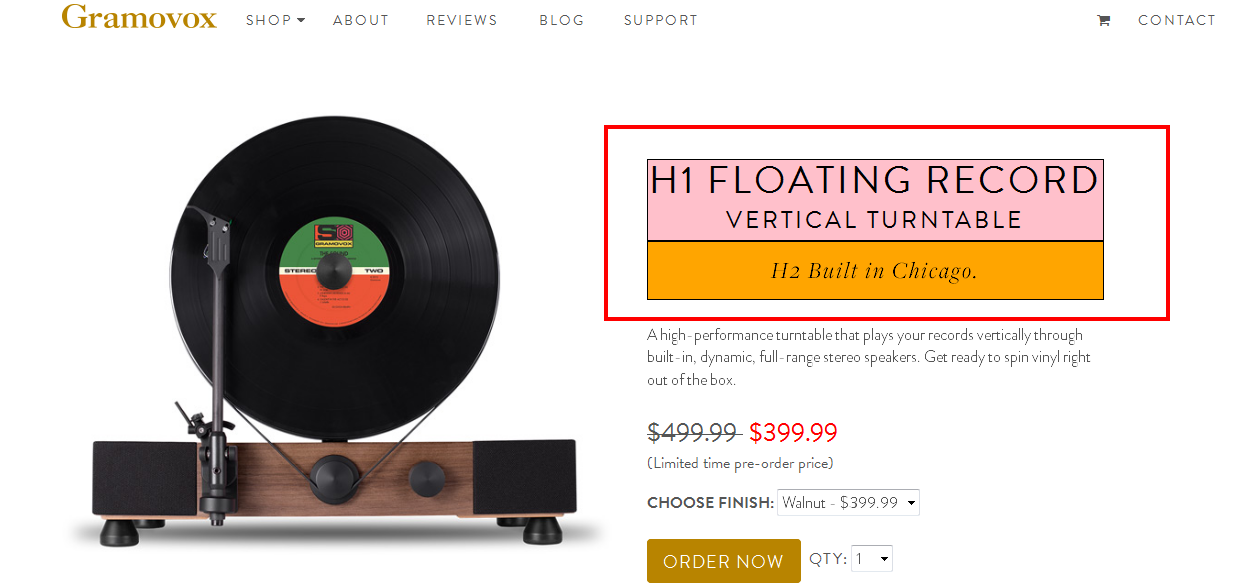
The H1 tag seems to incorporate some keywords, but they might consider testing some other variations. The same with the H2. It seems like the company takes pride in being built in Chicago, but is it worthy of being a heading tag? Again, heading tags should assist with search performance by incorporating keywords. They should also help site visitors find what they are looking for by scanning the page and not having to read all the content.
Here’s an example of their H3’s:
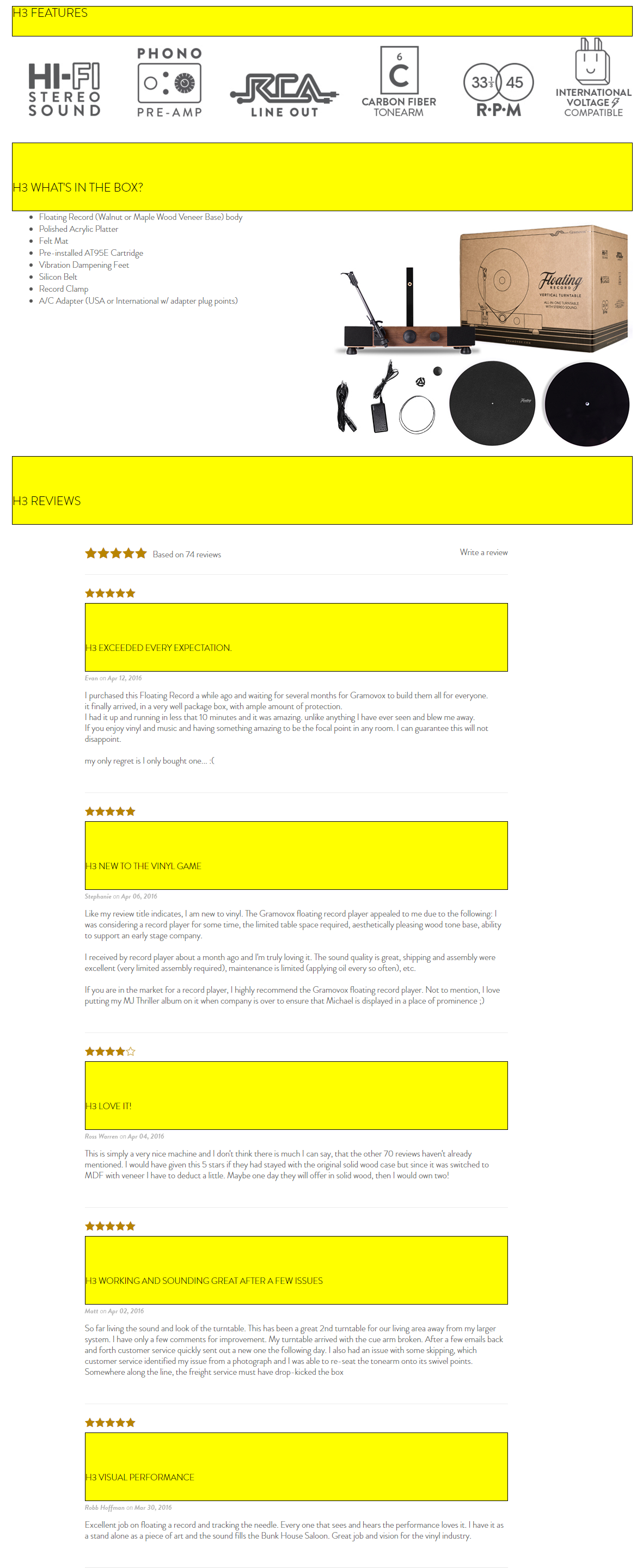
I’d suggest they make the review titles non-heading tags. The review titles are determined by the reviewer. So, if someone leaves a bad review, I’m sure Gramovox wouldn’t want a bad title to be a heading tag. The other H3 tags could be revised to include keywords, without making them appear over optimized. For example, “Features” could be made, “Vinyl Player Features,” or something similar. Same with the “Review” heading.
They also used H3 tags in the footer navigation:

Generally speaking, navigation elements shouldn’t be coded as heading tags.
Currently, their blog titles are H2 tags:
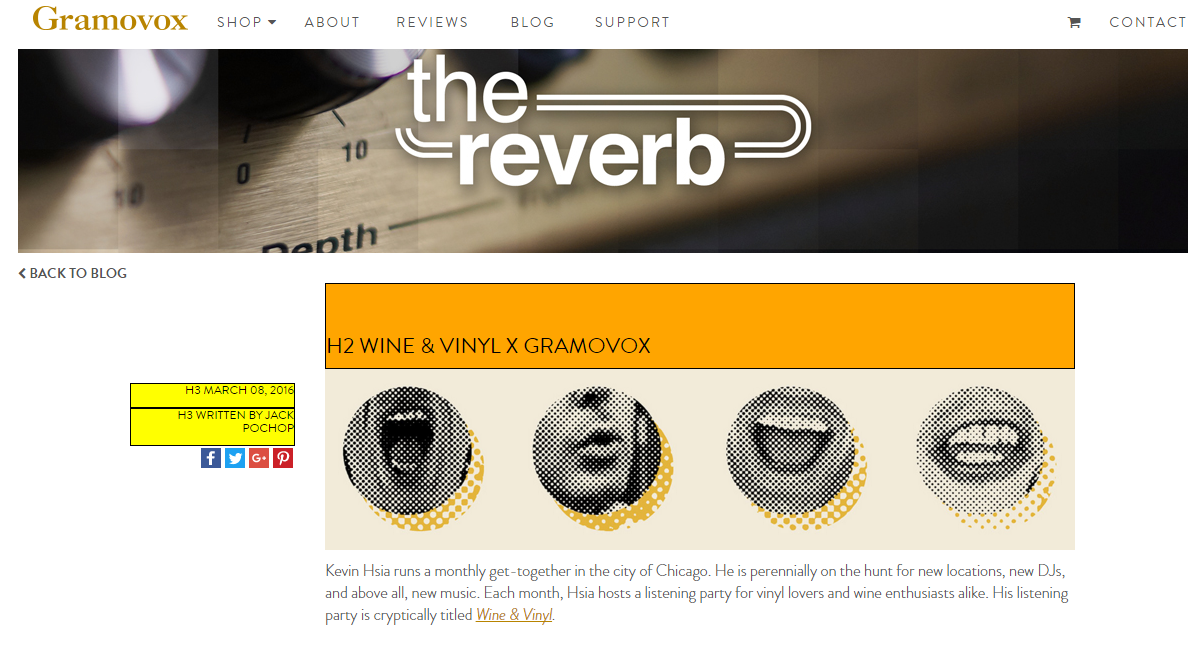
Blog posts are a great opportunity to incorporate broad term and long-tail keywords. I’d suggest Gramovox make their blog titles H1 tags. Think of it like the headline of a newspaper article. The headline is used to capture the attention of the audience and succinctly summarize what the article is about.
Heading changes are easy to make and could significantly impact search rankings, site usability and messaging.
Page Content
Since they only offer 3 products, they don’t have a lot of product pages. However, their product pages are still very important, and the content of those pages should be optimized to maximize their potential. Product pages usually consist of product details, features and descriptions — their product pages cover these things.
In reviewing their site, I noticed they have two floating record landing pages that have similar content: here and here. I’d suggest combining the two pages, keeping the (/products/floating-record) page and setting a 301 redirect from (/pages/floating-record) to (/products/floating-record).
Their blog should be used to grow their site content. It’s a platform where they can provide value to their audience while showcasing their knowledge, authority and passion. As with the other on-page elements, keywords should be worked in where applicable.
As I mentioned earlier, a good place to get content ideas is in your keyword research. Another area to explore for content ideas, is your product reviews. Let’s look at this review:
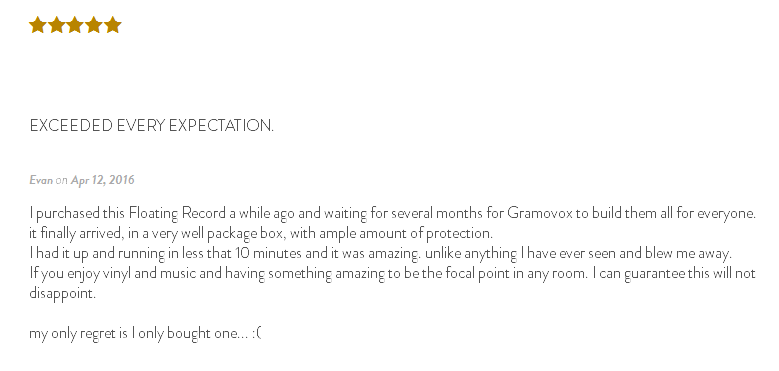
Here are some things I thought of when I read this review:
- Why did it take Gramovox several months to build the record player?
- How does Gramovox package the record player to ensure safe shipping?
- Does the set up really only take 10 minutes?
- Do people really notice the design of the record player?
The answers to these questions are some of the reasons the Gramovox product is unique, so they should be used to create content. They might also consider vetting music forums to discover what music lovers are discussing and join in on those conversations in order to take their content to the next level.
Image Alt Tags
Every image on the site should have an alt tag, and it appears most of their images do. However, most of the alt tags I looked at aren’t optimized with keywords and don’t accurately describe the image to search engines and visitors when the image isn’t available. Images without alt tags, or with meager alt tags, miss out on the opportunity that a well optimized alt tag has to increase search rankings and drive traffic to the site.
For instance, the Google search results for “record player,” looks like this:
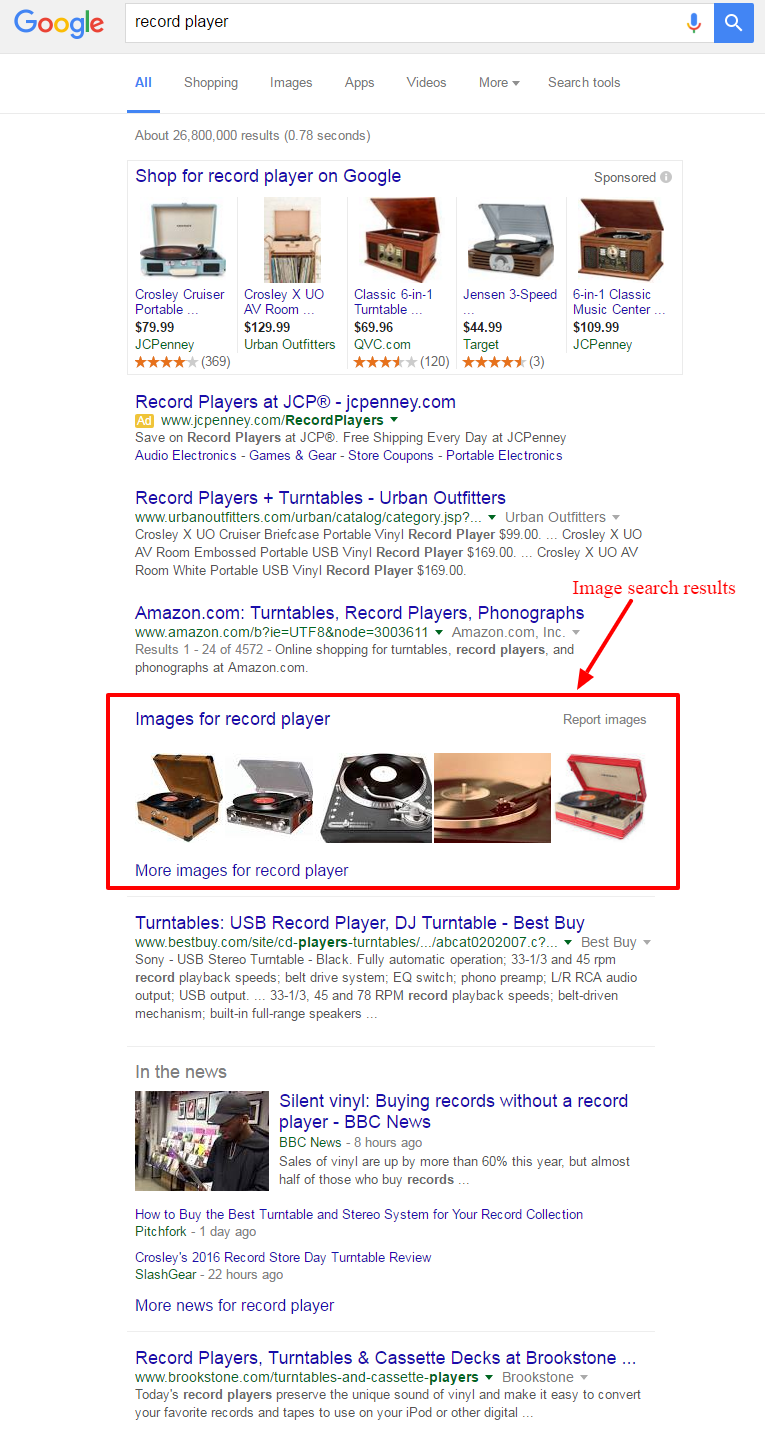
For most product-related searches, such as this one, Google displays a handful of images of products that match the search query.
Here’s an example from Gramovox:
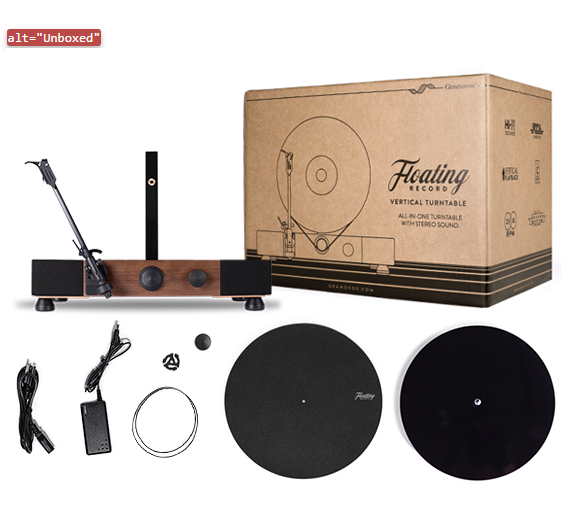
The current alt tag for this image is, “Unboxed.” A better alt tag would be, “Gramovox Vertical Turntable, Unboxed.”
Site Architecture
When search engines crawl a site to index pages, one of the things they factor in to the overall evaluation of the site is how easy it is for their crawlers to navigate. When the crawlers encounter certain issues, such as broken links, unnecessary redirects, duplicate content and other performance-killing factors, it disrupts and slows down their ability to crawl the site. This in turn affects visitors’ experience and the site’s performance in search.
Implementing proper fixes for these and other barriers paves the way for a better functioning website.
Broken Links & Redirects
Broken Links
If a site has a lot of broken links, search engines may not crawl it. If a search engine doesn’t crawl your site, your pages won’t get updated in their index, or won’t get indexed at all. Additionally, broken links impede the proper flow of link value throughout the site from page-to-page and hinders the user from having a positive experience.
I ran a tool called Xenu on the Gramovox site and found 97 broken links.
Here’s an example of an external broken link (links on Gramovox’s site that point to an external site):
http://pitchforkmusicfestival.com/about/
error code: 404 (not found), linked from page(s):
http://www.gramovox.com/blogs/posts/49215235-gramovox-at-pitchfork-music-festival
The “linked from” page (http://www.gramovox.com/blogs/posts/49215235-gramovox-at-pitchfork-music-festival) contains a link to http://pitchforkmusicfestival.com/about/.
If you try to navigate to that page, you’ll notice the URL is broken and results in a 404 error. Gramovox should change the linking URL to a URL that isn’t broken. If they can’t find a page on the website with content similar to the page they originally linked to, they should eliminate the link.
All the broken links on Gramovox’s site happen to be external links. It’s great that they don’t have any internal broken links (links to pages within their site).
Redirects
Redirects aren’t bad, but because some SEO value is lost in a redirect, it’s best to avoid having them whenever possible. Redirected links should be updated to avoid the redirection, if possible.
The purpose of a redirect is to forward one URL to a different URL. There are different types of redirects. The most common, and often the best type of redirect for SEO, is the 301 redirect. A 301 redirect is a permanent redirect that passes up to 99% of link value to the redirected link.
I used the same tool to check for redirects on the Gramovox site. There are some redirects on the site that they can update to avoid a redirection.
Here’s an example:
http://gramovox.com/support
redirected to: http://gramovox.com/blogs/support
status code: 301 (object permanently moved)
linked from page(s):
http://www.gramovox.com/pages/returns
The “linked from” page (http://www.gramovox.com/pages/returns) contains a link to http://gramovox.com/support. That URL is redirecting to the “redirected to” URL (http://gramovox.com/blogs/support) on the next line. If they change the linking URL on the linked from page to match the redirected to URL, this will eliminate the link from having to do a redirect.
Navigation
Your website’s navigation acts as road signs for visitors. It’s important to organize your site’s navigation in a way that helps visitors find what they are looking for with the least path of resistance.
I think Gramovox does a good job in their navigation of striking the balance between representing important pages while keeping the navigation clean and simple.
However, there are a few minor tweaks that could be made to further optimize their navigation.
Here’s how the main navigation looks:
![]()
If you click on the “Shop” button you’ll see the products they sell:

I suggest two minor adjustments here. First, change the “Shop” button to say “Products.” Products is a more intuitive label and brings exact clarity to what a user will get if they click on the button. Then, I would suggest changing the “click event” to a hover event. This simply means that instead of having to click on the button to see the product options, a user would only have to hover their mouse over the button to be presented with the sub-navigation options.
The other solution would be to add the products as navigation items, instead of listing in a sub-navigation under “Products.” So, the main navigation would be something like:

Since they have only two product categories, adding them to the navigation really only means adding one additional option. It’s still simple and clean.
The other way they might think of organizing the navigation is like this:
![]()
This separates the customer-focused and company-focused navigation.
As you can see, there are a lot of options. It’s a good idea to test the different variations and determine which option is best.
Overall, Gramovox is doing some things very well. They’ve kept their site and product line simple, but there are additional opportunities for them to capitalize on. This SEO Site Audit covers many major areas for consideration both from a user standpoint and from the perspective of improving search rankings. This, however, should not be seen as an exhaustive list. There are many additional factors that contribute to a website functioning optimally on all levels. Once Gramovox makes adjustments in these areas, they may want to dive into other tools to gather insights and find additional opportunities.
On a final note, I’ll be ordering my Gramovox floating record player soon.
